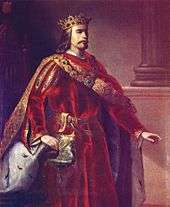Alfonso IV of Aragon
| Alfonso IV | |
|---|---|
 Seal of Alfonso IV | |
| King of Aragon, Valencia, Sardinia and Corsica, Count of Barcelona | |
| Reign | 2/5 November 1327 – 24 January 1336 |
| Predecessor | James II |
| Successor | Peter IV |
| Born |
2 November 1299 Naples |
| Died |
24 January 1336 (aged 36) Barcelona |
| Spouse |
Teresa d'Entença Eleanor of Castile |
| Issue |
Alfonso Constance, Queen of Majorca Peter IV, King of Aragon James I, Count of Urgell |
| House | House of Barcelona |
| Father | James II of Aragon |
| Mother | Blanche of Anjou |
Alfonso IV, called the Kind (also the Gentle or the Nice, Catalan: Alfons el Benigne) (2 November 1299 – 24 January 1336) was the King of Aragon[1] and Count of Barcelona[2] (as Alfonso III) from 1327 to his death. He was born in Naples, the second son of James II and Blanche of Anjou. His reign saw the incorporation of the County of Urgell, Duchy of Athens, and Duchy of Neopatria into the Crown of Aragon.
During the reign of his father, he was the procurator general of the Crown. He married Teresa d'Entença y Cabrera, heiress of Urgell, in 1314 in the Cathedral of Lerida. He is reputed to have been so liberal in the expenses during the wedding, that the local counsels imposed restrictions on how much he could spend. In 1323–1324, he undertook the conquest of Sardinia. He became heir after his older brother James renounced his rights to become a monk. In 1329, he began a long war with the Republic of Genoa. The city of Sassari surrendered in 1323, but rebelled three more times and was contested by Genoa.
After being widowed in 1327, Alfonso married in February 1329 Eleanor of Castile (1308–1359), who was betrothed to his brother James, who had refused to consummate the marriage. She was the sister of Alfonso XI of Castile. Because of some favoritism he showed towards his second wife, the last years of his life, he had to contend with the son of his first marriage, the future Peter IV.
Children

By Teresa d'Entença:
- Alfonso (1315–1317)
- Constance (1318–1346), married in 1336 to James III of Majorca.
- Peter IV (1319–1387), successor.
- James I, Count of Urgell (1321–1347), also inherited Entença and Antillon.
- Elizabeth (1323–1327).
- Frederick (1325-died young).
- Sancho (1327), lived only a few days.
- Ferdinand (1329–1363), Marquis of Tortosa and Lord of Albarracín and Fraga; married Maria, Marchioness of Tortosa.
- John (1331–1358), Lord of Elche, Biel and Bolsa, married in 1355 to Isabel Núñez de Lara (daughter of Juan Núñez III de Lara) and was killed by order of his cousin Pedro of Castile.
Ancestors
| 16. Peter II of Aragon | ||||||||||||||||
| 8. James I of Aragon | ||||||||||||||||
| 17. Maria of Montpellier | ||||||||||||||||
| 4. Peter III of Aragon | ||||||||||||||||
| 18. Andrew II of Hungary | ||||||||||||||||
| 9. Violant of Hungary | ||||||||||||||||
| 19. Yolanda de Courtenay | ||||||||||||||||
| 2. James II of Aragon | ||||||||||||||||
| 20. Frederick II, Holy Roman Emperor | ||||||||||||||||
| 10. Manfred of Sicily | ||||||||||||||||
| 21. Bianca Lancia | ||||||||||||||||
| 5. Constance of Sicily | ||||||||||||||||
| 22. Amadeus IV, Count of Savoy | ||||||||||||||||
| 11. Beatrice of Savoy | ||||||||||||||||
| 23. Marguerite of Burgundy | ||||||||||||||||
| 1. Alfonso IV of Aragon | ||||||||||||||||
| 24. Louis VIII of France | ||||||||||||||||
| 12. Charles I of Naples | ||||||||||||||||
| 25. Blanche of Castile | ||||||||||||||||
| 6. Charles II of Naples | ||||||||||||||||
| 26. Ramon Berenguer IV, Count of Provence | ||||||||||||||||
| 13. Beatrice of Provence | ||||||||||||||||
| 27. Beatrice of Savoy | ||||||||||||||||
| 3. Blanche of Anjou | ||||||||||||||||
| 28. Béla IV of Hungary | ||||||||||||||||
| 14. Stephen V of Hungary | ||||||||||||||||
| 29. Maria Laskarina | ||||||||||||||||
| 7. Maria of Hungary | ||||||||||||||||
| 30. Kuthen the Cuman | ||||||||||||||||
| 15. Elizabeth the Cuman | ||||||||||||||||
| 31. Galicie of Halicz | ||||||||||||||||
Notes
Sources
- Diccionario universal de historia y de geografía, p. 152. By Lucas Alamán, Manuel Orozco y Berra
- Medieval Iberia: an encyclopedia, Ed. E. Michael Gerli, Samuel G. Armistead, Routledge, 2003.
- O'Callaghan, Joseph F., A History of Medieval Spain, Cornell University Press, 1975.
| Alfonso IV of Aragon Cadet branch of the House of Barcelona Born: c. 1299 Died: 24 January 1336 | ||
| Regnal titles | ||
|---|---|---|
| Preceded by James the Just |
King of Aragon, Valencia, Sardinia and Corsica; Count of Barcelona 1327–1336 |
Succeeded by Peter the Ceremonious |
.svg.png)